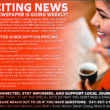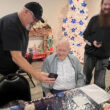Songs from the 1950’s-style musical “Doo-Wop Wed Widing Hood” blast from a pink boom box in the Foster Elementary School cafeteria.
Serena Backes sits beside two elementary school teachers, creating cut-out characters in poodle skirts and blue jeans as youngsters surround the table, singing along at the top of their lungs.
Backes, a junior in high school, has been working as a teacher’s assistant at the Foster School 20th Century Learning Center since December through a work experience program at Sweet Home High School. She is currently earning high school credits while working in an environment that will help her decide if she wants to pursue a career in teaching.
The program, called Cross-Age Mentoring, is designed to provide high school students with career-related experience in the professional fields that interest them, and everyone involved says it is beneficial: the students, the teachers, and the program administrators.
“(Students) are not doing this to fulfill a community service requirement,” said Nancy Ellis, the Career Center Coordinator at the high school.
“The state instituted four new graduation requirements beyond credit requirements. One of them is that they participate in career-related experiences.”
Sweet Home High School’s relationship with the 20th Century Learning Center began this school year and already six students have participated. Two are returning this spring, along with one other student.
The high school students spend a term working with elementary school children from every grade, alongside professional teachers. They are required to write daily journal entries about their experiences and meet individually with Ellis once a week to go over their entries and discuss the good and bad things that they experienced while working.
“It gives them experience to see if this is what they want to pursue,” Ellis said. “It saves them some money and grief and time.”
Rich Little, program administrator of the 20th Century Learning Center, said that having high school helpers broadens the program in a positive way.
“I truly believe that the more varied our staff is, the more we are able to offer our students,” he said.
The high school students have the same responsibilities as the regular teaching staff, such as attending staff meetings and training workshops, where they learn new skills, such as first aid and positive reinforcement techniques, Little said.
They work with every teacher and every student, playing games during recreation, working on art projects, offering homework help, and sometimes even just hanging out and chatting with the kids. Each student has a food-handlers permit so they can also help in the cafeteria.
We pretty much do everything during the course of the year,” said Alicia Baugus, a senior who helped out last term.
Glenna DeSouza, the principal at Foster Elementary, said that the high school students offer a younger perspective, so they are able to think of activities that will excite or intrigue the kids.
“It provides an opportunity for them to grow themselves, too, because once you start teaching, you learn more about the subject,” she said. “That could be social skills, as well…Since they’ve started, they’ve gained more confidence in knowing what to do and being able to help students.”
Although DeSouza said that she thinks the role modeling that the high school students offer is invaluable, Little said that the program provides an opportunity for students to go beyond the role of big brother and big sister and explore the leadership role of career education.
According to both the high school students and the regular staff members, the impact on the kids is obvious.
“I think there’s a good connection between high school students and elementary students,” DeSouza said. “What you see is a good social connection.”
Terri van Cleave, who has been teaching at the program since it began three years ago, said that she can see the children’s confidence increasing as they interact with the high school students.
“It’s really good for the kids to see and know that there are older kids who actually care about them,” she said. “There’s a pretty big impact. They’re more confident with themselves, (and) most of them are studying more.”
Backes agrees.
“I’ve seen some of them reach out a bit more and get into what the others are doing,” she said.
Jessica Andrade, a senior who worked as a teacher’s assistant in the fall and who plans to rejoin the Foster team during the spring term, said that the younger students really opened up to her through her time at the school, which she attributes to being closer to their age.
Some students still send her e-mails asking for advice with personal problems, such as how to get the interest of boys in their class, she said.
Through their experiences at Foster, Andrade, Backes and Baugus all say they’ve decided to pursue careers in teaching: Andrade as a high school Spanish teacher, Backes as an assistant pre-school teacher, and Baugus as either an elementary or high school teacher.
“I’ve learned a lot of techniques on how to talk to kids and how to deal with them a lot better because you can’t be nice all the time,” Baugus said. “It’s just a really good learning experience. I’m a lot more confident around kids now.”
Andrade and Backes agree, both stating that their involvement with Foster school has helped them learn new techniques and gain invaluable experience for their chosen careers.
“I see a great deal of pride in what (Serena) is doing now, and with Alicia and Jessica it was the same thing,” said Little. “They’re working with a lot of great professionals.”




